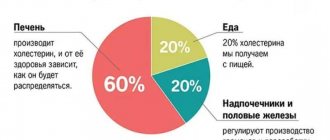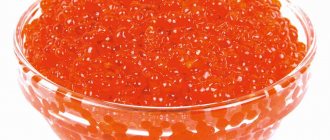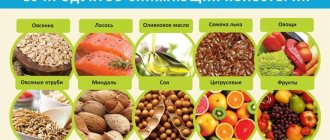Cod liver is considered a valuable source of unsaturated fatty acids and vitamins. However, the fat and calorie content of the product raise some doubts: is it worth eating cod liver oil if you have high cholesterol levels or is it better to abstain from this healthy delicacy?
The most correct answer to this question is “medicine differs from poison only in dose.”
Composition, nutritional value and benefits
Microelements in cod liver improve blood flow and vascular elasticity
Found in the cold waters near Iceland and Alaska, cod is considered one of the healthiest sea fish. Indeed, its low calorie content (only 78 kcal per 100 g) allows its meat to be used in the diet of people watching their weight. And the rich chemical composition makes it possible to include cod in the diet menu for various diseases.
About 20% of white cod meat is easily digestible proteins and only 0.5% is reserved for fats. Therefore, fish can be used even in the diet of small children, successfully replacing meat products.
However, the greatest value is cod liver - a unique product that contains almost all the elements of the periodic table and most of the known vitamins.
Fish oil is obtained from cod liver - a source of vitamin D, which is the basis for the formation and development of bone tissue, promotes the normal functioning of the endocrine system, improves the activity of the central nervous system and brain.
Thanks to the presence of Omega-3 and Omega-6 fatty acids, cod liver strengthens the immune system, increasing the body's defenses, normalizes the functioning of the cardiovascular system, and prevents premature aging of the body.
Scientific research has confirmed that cod liver is a powerful antioxidant. Regular use of this product, even in minimal quantities, reduces the risk of cancer by several times.
The nutritional value of cod liver is 610 kcal per 100 g. It also includes:
- proteins – 4.2 g;
- fats – 66 g;
- carbohydrates – 1.4 g.
From a medical point of view, cod liver has the following beneficial properties:
- reduces blood pressure;
- prevents the development of angina, arrhythmia and other diseases of the cardiovascular system;
- increases the body's resistance;
- strengthens the muscular system of the organs of vision, prevents the appearance of glaucoma;
- maintains normal blood sugar levels;
- improves skin conditions, strengthens teeth, hair, nails;
- normalizes the functioning of joints and bone apparatus;
- prevents diseases of the nervous system.
However, the high calorie content of the product raises a question among many: is it possible to eat cod liver with elevated blood cholesterol levels?
Characteristic
The fish's habitat covers the Atlantic Ocean (Baltic, White Sea, Arctic cod). In the east of the Atlantic it is distributed from Spitsbergen and the Barents Sea to the Bay of Biscay, in the west - from Greenland to Cape Hatteras. In particular, it lives in the Norwegian Sea, the Pacific Ocean, and off the coast of Iceland. Interestingly, only two types of fish are most often found under the trade name cod - Pacific and Atlantic. Baltic, White Sea, and Greenlandic ones are in less demand.
Cod can withstand low temperatures (from minus 1 degree Celsius and below). Her life expectancy reaches 25 years.
The young individual feeds on mollusks, small crustaceans. At the same time, by the age of three she becomes a real predator and begins to eat other fish: capelin, pollock, herring, and her own young. To catch cod, they use fixed and purse seines, snurrevods, bottom and pelagic trawls, and longlines.
This is a prolific fish that begins to lay offspring in March-April, making long 1,500-kilometer migrations to spawning grounds. Cod spawn in the water column; their numbers can reach up to 2 million in a few weeks.
In 1992, the Canadian government imposed a moratorium on fishing due to a sharp decline in the number of individuals and the threat of complete extinction of the species. This is the most important commercial fish, which is a raw material for the production of canned food and a source of valuable fish oil.
Large exporters of cod: Canada, Denmark, Great Britain, Norway, Russia, Iceland.
Cod liver and cholesterol
Thanks to a whole complex of vitamins and minerals, cod liver has a positive effect on the functioning of the heart and blood vessels, preventing the occurrence of many diseases. But, before including it in the daily menu, you should find out how much cholesterol is in the liver and whether it will cause harm to the body.
The cholesterol content in cod liver is 250 mg per 100 g. Considering that the daily intake from outside should not exceed 200 mg, this is quite a lot. Therefore, eating liver every day is not recommended even for absolutely healthy people.
However, scientists claim that in small quantities, cod liver not only does not increase cholesterol, but also helps reduce its deposition on the walls of blood vessels.
It has been proven that the presence of fish oil increases only “good” cholesterol, which is easily transported by the blood and does not lead to the formation of blood clots.
What kind of fish can you eat?
If you have high cholesterol levels, you are allowed to eat not all fish, but only less fatty ones. Typically, doctors recommend introducing mackerel, herring, mackerel, shrimp, squid and salmon into the diet, which contain a lot of Omega 3 and help vitamins be better absorbed.
If there is a problem with high cholesterol, then it is recommended to bake or fry the fish without vegetable oil and seasonings, which negatively affect metabolism.
When choosing seafood, special attention should be paid to its freshness; you should not buy frozen products or semi-finished products
Contraindications
The high calorie content does not allow cod liver to be included in the diet of people who are overweight or prone to obesity. In addition, this product should not be used in the following cases:
- allergies to seafood and fish;
- hypervitaminosis;
- low blood pressure;
- chronic diseases of the liver, pancreas and kidneys;
- pathologies of the biliary tract.
It is not recommended for women to eat cod liver during pregnancy, since an increased amount of minerals and vitamins can lead to disturbances in the development of the fetus.
Note to housewives
Classic recipe for cod with vegetables
Ingredients:
- cod – 1 carcass;
- carrots – 1 piece;
- lemon – 0.5 pieces;
- potatoes - 8 pieces;
- onion – 1 piece;
- rosemary – 2.5 grams (0.5 teaspoon)
- olive oil – 45 milliliters (3 tablespoons);
- black allspice, salt - to taste.
Cooking principle:
- Clean the carcass from scales, remove the entrails, cut off the head, and wash.
- Cut the back diagonally with a sharp knife.
- Grind pepper and salt in a mortar. Coat the cod with the mixture inside and out.
- Insert lemon slices into the slits.
- Cover a baking sheet with foil and place the fish on it.
- Peel potatoes, onions, carrots and cut into strips or rings.
- Drizzle the vegetables with olive oil, add salt and place on both sides of the cod, sprinkle with rosemary.
- Cover the top of the dish with foil, place in a preheated oven for 40 minutes, set the temperature to 180 degrees. Cook until potatoes are soft.
- When serving, decorate with herbs.
Cod casserole with rice
Ingredients:
- cod fillet – 400 grams;
- cream – 100 grams;
- rice – 250 grams;
- tomato sauce – 250 grams;
- hard cheese – 150 grams;
- egg - 2 pieces.
Cooking sequence:
- Cut the cod fillet into portions.
- Boil the rice until half cooked, grate 100 grams of cheese, and combine these ingredients.
- Place half of the resulting mass in a baking dish, then spread the fish over the surface, cover the cod with the remaining mass on top.
- Grate 50 grams of cheese on a coarse grater.
- Boil the eggs hard and chop. Combine with grated cheese and sprinkle on top.
- Mix cream and tomato sauce and pour over casserole. If desired, the dish can be sprinkled with breadcrumbs, and onions and cabbage can be added to the rice-cheese mixture.
- Preheat the oven, bake for 15 minutes at 180 degrees. Serve hot.
Dishes based on cod are tasty, light and satisfying. They can be eaten for dinner along with fresh vegetables and herbs.
Recommendations for selection
It is recommended to purchase cod liver in cans.
Cod liver is a perishable product, so it can only be purchased in canned form. When choosing a jar on store shelves, you need to pay attention to the following points:
- shelf life: no more than 2 years from the date of issue;
- the inscription: “Made at sea” means that the product is made from fresh, not frozen raw materials and has retained all the beneficial substances;
- composition of canned food: ideally, nothing should be present except the cod liver itself and olive oil.
An opened jar can be kept in the refrigerator for no more than a day. If longer storage is expected, then the contents should be transferred from a tin container to a glass container and closed with a lid.
Cod for pancreatitis
Cod fish meat is dietary and is recommended for consumption by patients with pancreatitis. Unlike pork, lamb, veal, and poultry, it lacks coarse fascia and tendons, it is tender and easily digestible. With minimal culinary effort, cod can be made into a dish with a puree-like consistency, which is especially important for a diet for pancreatitis, which involves grinding all food products in order to spare the digestive organs.
Fish is allowed to be consumed during the period of remission and exacerbation of the disease from the second week of the attack. It is boiled, steamed, served in the form of meatballs, cutlets, soufflés, quenelles, and meatballs. In addition to dishes prepared from minced cod, during the period of remission it is allowed to eat whole fish (baked, stewed, steamed). It makes nutritious casseroles and pies that will help diversify the patient’s diet.
Fish dumplings are recommended to be served with vegetable and cereal side dishes and vegetarian soups. In case of chronic pancreatitis, animal meat is replaced with cod, which is allowed to be consumed no more than 3 times a week. At the same time, the following fish dishes are prohibited: canned food, liver, aspic and broths that stimulate gastric and pancreatic secretion. In addition, avoid taking dried, smoked, or salted cod.
Remember, the healthiest fish is fresh. It should have a strong, elastic surface, be moderately shiny, and have a marine scent. The presence of yellowish stains on the carcass, damage, and a foul odor indicate long-term storage of the product on store shelves, which has been re-frozen. Avoid eating such fish.
The maximum daily portion of cod for a patient with pancreatitis is 200 grams.
How best to consume the delicacy
Since cod liver is a fatty and high-calorie product, it is not recommended to eat it as an independent dish. It will be much tastier and healthier if you include it in various cold appetizers.
Cod liver goes best with the following products:
- hard cheese;
- eggs;
- white and rye bread;
- fresh vegetables - cucumbers, tomatoes, Chinese cabbage, radishes, onions;
- nuts;
- greens - parsley, dill, lettuce, arugula.
The most popular dishes with cod liver are all kinds of sandwiches, canapés, pates and salads. In addition, it is well suited for filling baskets, profiteroles or pancakes.
Due to the fat content of cod liver, it is recommended to use it only in combination with other products.
Historical information
Content:
- Historical information
- Characteristic
- Beneficial features
- Cod liver
- Chemical composition
- Cod roe
- Using fish in cooking
- Cod for pancreatitis
- How to cook cod?
- Note to housewives
- Conclusion
Cod has played an important role in the history of Europe and America for more than a thousand years. The Vikings who lived on the Lofoten Islands ate dried fish. Immediately after the catch, it was hung in an open, well-ventilated area; after three months, the carcasses were beaten until the meat became soft and edible. Such nutritious food was stored for a long time, which was ideal for a wandering tribe.
Fish then gained popularity in Europe for religious reasons: unlike meat, it could be eaten during Lent.
Between 1958 and 1976, a diplomatic conflict arose over cod. The controversy stemmed from the first state's imposition of a 200-mile economic zone around the island, which prohibited fishing in Icelandic waters where British fishermen were casting their nets.
Interestingly, the maximum weight of the largest cod caught in history was 96 kilograms.
For men
The benefits of canned food for men's health have been proven. Seafood has a beneficial effect on the genitourinary system and hormone production. Potency increases, which is an important factor for:
- improving reproductive function;
- increasing internal self-esteem;
- reducing depressive factors.
The liver contains substances that affect sperm motility. It contains minerals that promote rapid recovery after heavy physical activity. This property is used by athletes; they include liver in their daily diet.
What harm is there from fish?
As such, fish is not harmful if it is fresh and has undergone proper heat treatment. The freshness and quality of the fish is also affected by the aquatic environment in which it lived.
Chemical waste is often thrown into waters, which can negatively affect the product, making it poisonous, which will certainly affect health in the future:
- The stable functioning of the kidneys and liver may be disrupted, and in women, the ovaries.
- Diseases and dysfunctions of the gastrointestinal tract (especially problems with the pancreas) may develop.
- Old and sick fish cause metabolic and circulatory problems.
- Hormonal metabolism and the functioning of the genital organs in men may be disrupted (leading to infertility and other dangerous diseases, including oncology).
Spoiled fish or fish caught in dirty waters can harm everyone, especially children and pregnant women. If a pregnant woman has high cholesterol, or the product is stale, this can lead to miscarriage or diseases of the digestive system. Therefore, before eating fish, you should make sure that it is fresh and does not pose a threat to health.
The spoiled product should not be eaten under any circumstances.











